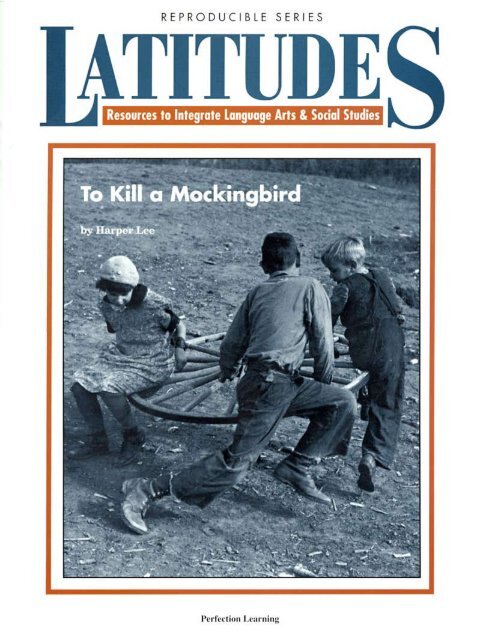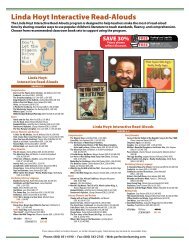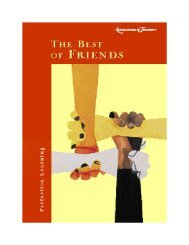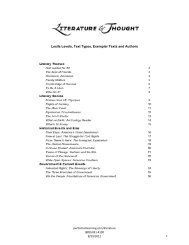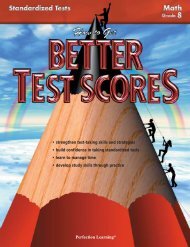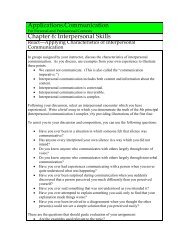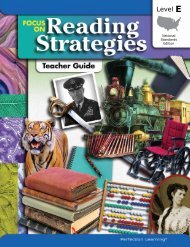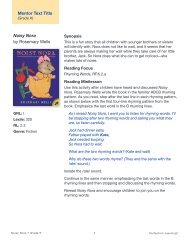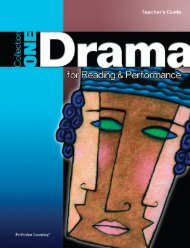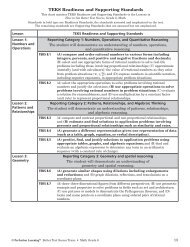Teacher ResourceâTo Kill a Mockingbird - Perfection Learning
Teacher ResourceâTo Kill a Mockingbird - Perfection Learning
Teacher ResourceâTo Kill a Mockingbird - Perfection Learning
- No tags were found...
Create successful ePaper yourself
Turn your PDF publications into a flip-book with our unique Google optimized e-Paper software.
TABLE OF CONTENTS<br />
About the Novel<br />
Introduction. . . . . . . . . . . . . . . . . . . . . . . . . . . . . . . . . . . 6<br />
Story Synopsis . . . . . . . . . . . . . . . . . . . . . . . . . . . . . . . . . 8<br />
About the Author . . . . . . . . . . . . . . . . . . . . . . . . . . . . . . . 10<br />
Critics’ Comments . . . . . . . . . . . . . . . . . . . . . . . . . . . . . . 11<br />
Voices from the Novel . . . . . . . . . . . . . . . . . . . . . . . . . . . . 12<br />
Glossary . . . . . . . . . . . . . . . . . . . . . . . . . . . . . . . . . . . . 13<br />
About the Period<br />
A Time in History . . . . . . . . . . . . . . . . . . . . . . . . . . . . . . 14<br />
The Geographical Picture . . . . . . . . . . . . . . . . . . . . . . . . . . 15<br />
Another Small-Town Halloween Party . . . . . . . . . . . . . . . . . . 16<br />
Proper Clothes—Proper Behavior . . . . . . . . . . . . . . . . . . . . . 18<br />
Morphine: A Southern Lady’s Drug . . . . . . . . . . . . . . . . . . . . 19<br />
Cotton Picking and “the Bear” . . . . . . . . . . . . . . . . . . . . . . . 20<br />
The Great Depression . . . . . . . . . . . . . . . . . . . . . . . . . . . . 22<br />
Help Your Poor Neighbor . . . . . . . . . . . . . . . . . . . . . . . . 22<br />
Dear Mr. President. . . . . . . . . . . . . . . . . . . . . . . . . . . . 24<br />
About Race Relations<br />
Viewpoints on Equality . . . . . . . . . . . . . . . . . . . . . . . . . . . 26<br />
Legal Segregation . . . . . . . . . . . . . . . . . . . . . . . . . . . . . . 28<br />
Justice for All . . . . . . . . . . . . . . . . . . . . . . . . . . . . . . . . . 29<br />
Separate but Equal . . . . . . . . . . . . . . . . . . . . . . . . . . . . . 30<br />
A Southern Vacation . . . . . . . . . . . . . . . . . . . . . . . . . . . . . 31<br />
Lynching . . . . . . . . . . . . . . . . . . . . . . . . . . . . . . . . . . . . 32<br />
Moral Cowardice . . . . . . . . . . . . . . . . . . . . . . . . . . . . . 32<br />
Southern Women Speak Out Against Lynching . . . . . . . . . . . 33<br />
An Occurrence in Scottsboro, Alabama . . . . . . . . . . . . . . . . . . 34<br />
Haywood Patterson . . . . . . . . . . . . . . . . . . . . . . . . . . . 34<br />
Ruby Bates . . . . . . . . . . . . . . . . . . . . . . . . . . . . . . . . 36<br />
Why I Joined the Klan . . . . . . . . . . . . . . . . . . . . . . . . . . . . 37<br />
An Interview with Thurgood Marshall . . . . . . . . . . . . . . . . . . 38<br />
Nazi Racism . . . . . . . . . . . . . . . . . . . . . . . . . . . . . . . . . . 39<br />
Mein Kampf . . . . . . . . . . . . . . . . . . . . . . . . . . . . . . . . 39<br />
Jesse and Luz . . . . . . . . . . . . . . . . . . . . . . . . . . . . . . . 40<br />
continued
TABLE OF CONTENTS<br />
continued<br />
Comparative Works<br />
Voices from Other Works . . . . . . . . . . . . . . . . . . . . . . . . . . 41<br />
Poetic Perspectives . . . . . . . . . . . . . . . . . . . . . . . . . . . . . . 42<br />
Suggested Reading and Viewing List . . . . . . . . . . . . . . . . . . . 44<br />
Suggested Activities<br />
Using Latitudes in Your Classroom . . . . . . . . . . . . . . . . . . . 48<br />
Student Projects . . . . . . . . . . . . . . . . . . . . . . . . . . . . . . . 56
A Time in<br />
HISTORY<br />
The following timeline traces some of<br />
the major events dealing with race relations<br />
and the Great Depression.<br />
1890<br />
1900<br />
1910<br />
1920<br />
1930<br />
1940<br />
1950<br />
U.S. Supreme Court decision in<br />
Plessy v. Ferguson makes segregation<br />
on railroad cars legal<br />
(1896)<br />
NAACP is founded (1909)<br />
Ku Klux Klan receives charter<br />
from Fulton County, Georgia;<br />
Klan spreads to other<br />
Southern states (1915)<br />
U.S. Congress fails to pass antilynching<br />
bill (1922)<br />
Haywood Patterson, one of the<br />
Scottsboro defendants,<br />
escapes from prison and<br />
flees to the North (1948)<br />
Last of the Scottsboro defendants<br />
freed on parole (1950)<br />
1930<br />
1931<br />
1932<br />
1933<br />
1934<br />
1935<br />
1936<br />
1937<br />
1938<br />
1939<br />
1940<br />
Great Depression (1929-1939)<br />
First meeting of the Association of<br />
Southern Women for the<br />
Prevention of Lynching (1930)<br />
Nine African-American youths<br />
charged with the rapes of two<br />
white women in Scottsboro,<br />
Alabama; eight of the nine convicted<br />
and sentenced to death<br />
(1931)<br />
U.S. Supreme Court reverses convictions<br />
of the seven Scottsboro defendants<br />
on grounds that their<br />
constitutional rights were violated<br />
(November 7, 1932)<br />
Second Alabama trial of the<br />
Scottsboro Boys; defendants again<br />
convicted (1933)<br />
Franklin D. Roosevelt elected 32nd<br />
President of the United States<br />
(1933)<br />
NRA (National Recovery<br />
Administration) begins (1933)<br />
Hitler named German chancellor<br />
(1933)<br />
U.S. Supreme Court again reverses<br />
Scottsboro convictions (1935)<br />
WPA (Works Progress<br />
Administration) begins (1935)<br />
Jesse Owens wins gold medal in<br />
Summer Olympics in Germany<br />
(1936)<br />
Franklin D. Roosevelt reelected U.S.<br />
President (1936)<br />
Four Scottsboro defendants freed;<br />
others sentenced to long prison<br />
terms (1937)<br />
World War II begins (1939)<br />
Nazi invasion of Poland (1939)<br />
14 © 1994 <strong>Perfection</strong> <strong>Learning</strong> Corporation, Logan, Iowa.
Another Small-Town<br />
Halloween Party<br />
Harper Lee based most of the<br />
characters and events in To<br />
<strong>Kill</strong> a <strong>Mockingbird</strong> on her<br />
own childhood experiences in<br />
Monroeville, Alabama. For<br />
example, Atticus is very much<br />
like Lee’s own father, and Dill is<br />
drawn from her playmate,<br />
author Truman Capote.<br />
An incident told in a biography<br />
of Capote reveals the similarities<br />
between the characters<br />
and events in Lee’s early life<br />
and those in her novel. In<br />
A Bridge of Childhood:<br />
Truman Capote’s Southern<br />
Years, author Marianne M.<br />
Moates tells of events that<br />
occurred during a Halloween<br />
party Truman gave at the home<br />
of his aunt, a neighbor of the<br />
Lees. Here we learn that sometimes<br />
even whites weren’t safe<br />
at the hands of the Ku Klux<br />
Klan.<br />
Note: The story is told in the<br />
voice of Big Boy, Truman’s cousin and a<br />
friend of both Truman and Harper Lee. In<br />
the following excerpt, Harper Lee is<br />
referred to as “Nelle.”<br />
T<br />
he party was in full swing when Sally<br />
Boular, dressed in a fluffy princess costume,<br />
burst into the house, shrieking,<br />
“Help! Please help! The Klan’s got Sonny<br />
over at Mr. Lee’s house! They’re gonna<br />
hang him!”<br />
She screamed her words as she<br />
described what happened. “We got on our<br />
costumes and walked as far as the Lees’<br />
Harper Lee and her father, Amasa, at home in Alabama, 1961<br />
when the Klan saw us. They yelled,<br />
‘There’s one of them now!’ and started<br />
running after us. We got scared and<br />
started running. Sonny tripped and fell<br />
in Mr. Lee’s yard. He couldn’t get up.<br />
They grabbed him and said they’re gonna<br />
hang him! Come quick!”<br />
Someone yelled, “Call the sheriff!”<br />
While the adults crowded to the door<br />
in a hubbub of activity, Truman, Nelle,<br />
and I darted out the back door, down the<br />
steps, across the yard, and through the<br />
hedge. We reached Nelle’s front porch<br />
before any of the adults managed to get<br />
there. All except Mr. Lee, who had heard<br />
continued<br />
16 © 1994 <strong>Perfection</strong> <strong>Learning</strong> Corporation, Logan, Iowa.<br />
Don Uhrbrock, Life Magazine
Another Small-Town Halloween Party continued<br />
Truman Capote<br />
Granger Collection<br />
the commotion and was standing outside<br />
in his undershirt and blue pants. He<br />
waded into the middle of the sheetcovered<br />
Klansmen, who had gathered in<br />
the middle of the road holding their<br />
torches high.<br />
The Klansmen didn’t offer any resistance<br />
to Mr. Lee, a big, strong man who<br />
had the respect of everybody in town. He<br />
was a member of the state legislature,<br />
editor of the Monroe Journal, and an<br />
upstanding citizen. No one wanted to be<br />
the one to cross him. When Mr. Lee got to<br />
the center of the activity, he came face-toface<br />
with a Klansman wearing a hood<br />
with green fringe. This was the Grand<br />
Dragon.<br />
In the center of the group was a series<br />
of silver-painted cardboard boxes that<br />
had been wired to make a square head,<br />
body, arms, and legs. Round eye-holes<br />
were cut in the front of the box on the<br />
head. The strange figure could barely<br />
walk with all the boxes wired to him, and<br />
he couldn’t get his arms up to pull the<br />
box from his head....When [Mr. Lee]<br />
finally removed the box, there was Sonny,<br />
white as a sheet, with tears streaming<br />
down his face. He tried to cling to Mr.<br />
Lee, but the boxes kept him back. “I<br />
wasn’t going to hurt anybody,” he said. “I<br />
was coming to the party as a robot, that’s<br />
all.”<br />
Mr. Lee turned to address the crowd of<br />
Klansmen. “See what your foolishness<br />
has done You’ve scared this boy half to<br />
death because you wanted to believe<br />
something that wasn’t true. You ought to<br />
be ashamed of yourselves.”...<br />
One by one [the Klan members] silently<br />
ground their torches into the dirt and<br />
faded into the blackened night....<br />
While we discussed the excitement and<br />
danger, Truman was getting it all in perspective.<br />
Then his comments and questions<br />
bubbled out: “...How about Mr. Lee<br />
Did you notice after he spoke there was<br />
no shouting, no more talk Did you see<br />
the look on the people’s faces” He<br />
paused, then said thoughtfully, “The<br />
power of the Klan is gone. Nobody has to<br />
be afraid of them anymore.”<br />
© 1994 <strong>Perfection</strong> <strong>Learning</strong> Corporation, Logan, Iowa.<br />
17
MORPHINE<br />
A Southern Lady’s Drug<br />
Morphine is a highly addictive pain reliever that is still<br />
used today, although it is strictly regulated. In the early<br />
1900s, morphine addiction was more than an isolated<br />
occurrence. Following is a look at the “typical” morphine<br />
addict of the early 20th century. The data are summarized<br />
from Dark Paradise by David T. Courtwright.<br />
1920s Typical Morphine Addict<br />
• white female<br />
• middle-aged or older<br />
• widowed<br />
• homebound<br />
• lives in the South<br />
• property owner<br />
• began using morphine<br />
for medical reasons<br />
T<br />
The account that follows, from Courtwright’s book,<br />
shows how Mrs. Dubose in To <strong>Kill</strong> a <strong>Mockingbird</strong><br />
typifies the morphine addict of her time.<br />
here is, by way of summing up, a character in Harper Lee’s novel<br />
To <strong>Kill</strong> a <strong>Mockingbird</strong> named Mrs. Henry Lafayette Dubose. Mrs.<br />
Dubose is a propertied and cantankerous widow residing in a small<br />
Alabama town. She is also a morphine addict, having become addicted<br />
years ago as a consequence of a chronic, painful condition. Informed<br />
that she has only a short while to live, she struggles to quit taking the<br />
drug, for she is determined to “leave this world beholden to nothing<br />
and nobody.” Although fictitious, Mrs. Dubose personifies the<br />
American opium or morphine addict of the late nineteenth and early<br />
twentieth centuries. If all of the foregoing statistics were condensed<br />
into a single, modal type, it would closely resemble Mrs. Dubose: a<br />
native Southerner, possessed of servant and property, once married,<br />
now widowed and homebound, evidently addicted since late middle<br />
age. In all respects—her sex, age of addiction, race, nationality,<br />
region, class, and occupation (or lack thereof)—she is typical. Typical,<br />
too, is the origin of her condition: she was addicted by her physician.<br />
© 1994 <strong>Perfection</strong> <strong>Learning</strong> Corporation, Logan, Iowa.<br />
19
VIEWPOINTS<br />
on Equality<br />
These quotes from speeches,<br />
letters, books, and pamphlets<br />
reveal some<br />
Americans’ feelings on race<br />
relations and equality.<br />
Not many of the aspects of<br />
life in Alabama are<br />
untouched by the influence<br />
of racial attitudes. The<br />
Negro problem has given a<br />
distinct coloration to our<br />
judicial procedures, to our<br />
social attitudes, to our educational<br />
points of view and<br />
even to our artistic and scientific<br />
endeavors. Religion<br />
itself has not been immune<br />
to the influence.<br />
—Birmingham News<br />
(January 12, 1934)<br />
...To the Negro in these<br />
counties in the South the<br />
image of America is the<br />
image of the Sheriff.<br />
—James Nabrit, Jr.,<br />
May 1, 1963<br />
As a race the Negro is definitely<br />
inferior to the white.<br />
The only fields in which<br />
they are superior are in<br />
their physical strength and<br />
their natural capacity as<br />
entertainers, making fun of<br />
themselves for the benefit of<br />
others.<br />
—Robert Patterson,<br />
journalist<br />
John Dewey<br />
The Granger Collection<br />
Belief in equality is an element<br />
of the democratic<br />
credo....All individuals are<br />
entitled to equality of treatment<br />
by law and in its<br />
administration. Each one is<br />
affected equally in quality if<br />
not in quantity by the institutions<br />
under which he lives<br />
and has an equal right to<br />
express his judgment....In<br />
short, each one is equally an<br />
individual and entitled to<br />
equal opportunity of development<br />
of his own capacities,<br />
be they large or small<br />
in range.<br />
—John Dewey,<br />
Intelligence in the Modern<br />
World, 1939<br />
The real problem is not the<br />
negro, but the white man’s<br />
attitude toward the negro.<br />
—Thomas Pearce Bailey,<br />
1914<br />
We consider the underlying<br />
fallacy of the plaintiff’s<br />
argument to consist in the<br />
underlying assumption that<br />
the enforced separation of<br />
the two races stamps the<br />
colored race with a badge of<br />
inferiority. If this be so, it is<br />
not by reason of anything<br />
found in the act, but solely<br />
because the colored race<br />
chooses to put that construction<br />
on it.<br />
—Justice<br />
Henry B. Brown,<br />
who argued with the<br />
majority opinion in<br />
Plessy v. Ferguson, 1896<br />
Our Constitution is colorblind,<br />
and neither knows<br />
nor tolerates classes among<br />
citizens. In respect of civil<br />
rights, all citizens are equal<br />
before the law.<br />
—Justice<br />
John Marshall Harlan<br />
(the only Southerner on the<br />
Supreme Court), who disagreed<br />
with the majority<br />
opinion in Plessy v.<br />
Ferguson, 1896<br />
The problem of the twentieth<br />
century is the problem of<br />
the color line—the relation<br />
of the darker to the lighter<br />
races of men in Asia and<br />
Africa, in America and the<br />
islands of the sea.<br />
—W. E. B. DuBois,<br />
1903<br />
continued<br />
26 © 1994 <strong>Perfection</strong> <strong>Learning</strong> Corporation, Logan, Iowa.
Viewpoints continued<br />
Now where rests the responsibility<br />
for the lynch law<br />
prevalent in the South It is<br />
evident that it is not<br />
entirely with the ignorant<br />
mob. The men who break<br />
open jails and with bloody<br />
hands destroy human life<br />
are not alone responsible.<br />
These are not the men who<br />
make public sentiment.<br />
They are simply the hangmen,<br />
not the court, judge, or<br />
jury. They simply obey the<br />
public sentiment of the<br />
South—the sentiment created<br />
by wealth and<br />
respectability, by the press<br />
and pulpit. A change in public<br />
sentiment can be easily<br />
effected by these forces<br />
whenever they shall elect to<br />
make the effort. Let the<br />
press and the pulpit of the<br />
South unite their power<br />
against the cruelty, disgrace<br />
and shame that is settling<br />
like a mantle of fire upon<br />
these lynch-law States, and<br />
lynch law itself will soon<br />
cease to exist.<br />
—Frederick Douglass,<br />
August 11, 1892<br />
Langston Hughes<br />
LOC<br />
Eleanor Roosevelt<br />
LOC<br />
I think understanding and<br />
sympathy for the white people<br />
in the South is as important<br />
as understanding and<br />
sympathy and support for<br />
the colored people. We don’t<br />
want another war between<br />
the states and so the only<br />
possible solution is to get<br />
the leaders on both sides<br />
together and try to work<br />
first steps out.<br />
—Eleanor Roosevelt,<br />
1956<br />
We Negroes of America are<br />
tired of a world divided<br />
superficially on the basis of<br />
blood and color, but in<br />
reality on the basis of poverty<br />
and power—the rich over<br />
the poor, no matter what<br />
their color. We Negroes of<br />
America are tired of a world<br />
in which it is possible for<br />
any one group of people to<br />
say to one another: “You<br />
have no right to happiness,<br />
or freedom, or the joy of<br />
life.”...We are tired of a<br />
world where, when we raise<br />
our voices against oppression,<br />
we are immediately<br />
jailed, intimidated, beaten,<br />
sometimes lynched.<br />
—Langston Hughes,<br />
1937<br />
What, then, is the cause of<br />
lynching At the last analysis,<br />
it will be discovered that<br />
there are just two causes of<br />
lynching. In the first place,<br />
it is due to race hatred, the<br />
hatred of a stronger people<br />
toward a weaker who were<br />
once held as slaves. In the<br />
second place, it is due to the<br />
lawlessness so prevalent in<br />
the section where ninetenths<br />
of the lynchings<br />
occur.<br />
—Mary Church Terrell,<br />
1904<br />
Nowhere in the civilized<br />
world save the Unites States<br />
of America do men, possessing<br />
all civil and political<br />
power, go out in bands of 50<br />
to 5000 to hunt down, shoot,<br />
hang or burn to death a single<br />
individual, unarmed and<br />
absolutely powerless....We<br />
refuse to believe this country,<br />
so powerful to defend its<br />
citizens abroad, is unable to<br />
protect its citizens at home.<br />
—Ida B. Wells,<br />
1898<br />
We are citizens just as much<br />
or more than the majority of<br />
this country....We are just as<br />
intelligent as they. This is<br />
supposed to be a free country<br />
regardless of color, creed<br />
or race but still we are<br />
slaves....We did not ask to<br />
be brought here as slaves,<br />
nor did we ask to be born<br />
black. We are real citizens of<br />
this land and must and will<br />
be recognized as such!<br />
—Mrs. Henry Weddington,<br />
in a 1941 letter to President<br />
Franklin Roosevelt<br />
© 1994 <strong>Perfection</strong> <strong>Learning</strong> Corporation, Logan, Iowa.<br />
27


